If you are wondering what are the different types of angelfish you can keep in your freshwater aquarium then you are in the right place.
In this article, I am going to show you 15 types of angelfish available to keep in a freshwater tank.
So let’s begin the list.
Table of Contents
13 Types of Angelfish for Freshwater Aquarium

1. Gold Veil Angelfish
Gold Veil angelfish have Golden and white coloration.
This type of angelfish has thin and long fins that can grow more than the length of the body of the Angelfish.
Gold veil angelfish comes from the Amazon river basin of South America and its natural habitat is heavily planted.
So, ideally, you should keep it in a heavily planted aquarium.
You should also add some rocks and driftwood to emulate its natural habitat.
The minimum recommended tank size for this fish is 30 gallons.
For proper growth and development of Gold Veil Angelfish, you should feed it a variety of foods.
Its diet should consist of vegetables and meaty food like frozen and live bloodworms brine shrimp etc.
This type of angelfish is slow-moving so you should also make sure that it is getting sufficient food if you are going to put it in the community tank.
Besides, Gold veil angelfish are very delicate when it is small so maintaining good water quality and providing a variety of food is key when it comes to the proper growth of this angelfish.
As they reach adulthood they become hardy.
15 Things You Must Know Before Buying Your First Aquarium
2. Black Lace Angelfish
Black lace angelfish is one of the most attractive angelfish in the aquarium hobby.
This fish comes from Central Amazon tributaries of eastern Ecuador and Peru.
It features dark black coloration with a lace pattern on the fins.
This fish is quite rare to find if but if you find it you should definitely keep it in your aquarium.
It is also one of the easy fish to keep so you can easily keep it in your aquarium even if you are a beginner.
This type of angelfish is omnivorous and you should feed them a variety of food like frozen and live bloodworms, brine shrimp, etc.
You should also feed vegetables and flake food to this angelfish.
3. Leopard Angelfish
Leopard angelfish are not as common as other types of angelfish but they look really amazing in an aquarium.
This Angelfish does not have stripes instead it has spots that look similar to Leopard thus the name.
It features black, grey and silver coloration.
It has long and thin fins that feature a web-like pattern and usually, it grows longer than the body of the fish.
For proper growth, you should feed it a variety of food. You should feed it meaty food like frozen or live bloodworms, brine shrimp and flake food.
You should also feed it vegetables.
To maintain and retain leopard-like spots when it reaches its adulthood, you should provide it optimum lighting.
If it doesn’t get sufficient lighting then its body pigment will change and the spots will disappear.
Besides, you should also be very careful about the water quality and provide it as good water quality as possible.
You can easily do so by keeping up with the water change.
12 Best Freshwater Fish for Aquarium (5th is the Coolest You’ve Ever Seen)
4. Silver Angelfish
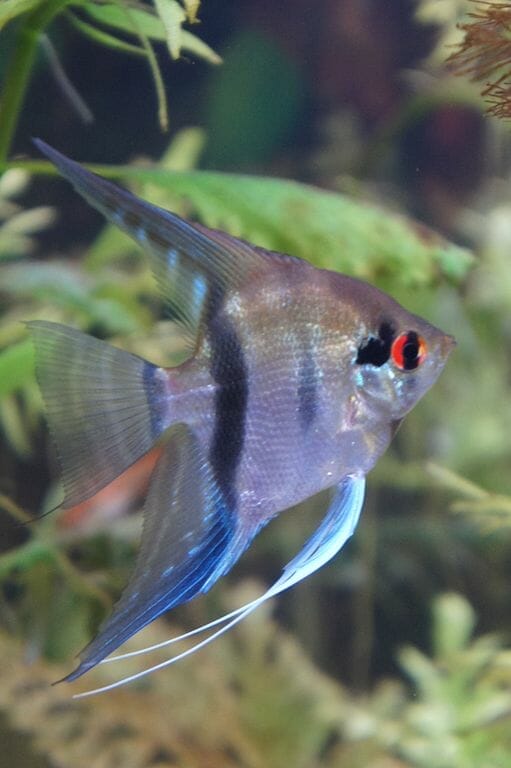
Image by Corpse89 under CC BY-SA 3.0
Silver angelfish is one of the most popular types of angelfish in the aquarium hobby.
The best part about this angelfish is that it is very hardy.
And it is also very easy to care for which makes it an ideal choice for beginners.
This type of angelfish is very similar to the wild species of the Angelfish.
As the name suggests this angelfish features silver color along with its signature three stripes.
One stripe goes through its eye and the other two stripes are on its body.
The interesting fact about these three stripes is that it will fade away or darken depending on the mood of the angelfish.
5. Marble Angelfish
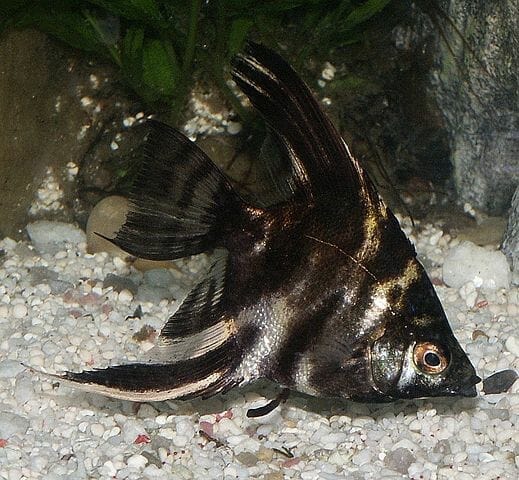
Marble angelfish looks similar to Zebra angelfish.
But this fish features marbling on its body.
It comes in different many different color variations but usually, it has black, white and yellow colors.
This is one of the most durable angelfish and it is very easy to care for which makes it a very good choice for beginners who want to keep angelfish.
Besides, it is also very resistant to diseases and it can adapt to changes such as a sudden change in water temperature, pH and hardness, etc.
For proper growth, you should feed it a variety of food.
You can feed it frozen or live bloodworms, brine shrimp and flake food.
You should also feed it vegetables regularly.
6. Blushing Angelfish
Blushing angelfish is very easy to identify.
It features only one color on its body i.e. reddish color on the chicks or the gills of the fish.
Actually, there is no coloration on the gills or chicks of this angelfish.
Instead, it is actually the lack of pigmentation so you can see through the gills.
So it seems like it has a reddish coloration and it looks like this angelfish is blushing thus the name “Blushing angelfish”.
This angelfish typically don’t have any stripes or any other coloration on the body.
When the fish reaches its maturity, typically its body is Golden.
That’s why it looks similar to the Golden fish.
As with all the Angelfish, you should feed it a variety of food for its proper growth.
13 Easy to Care Freshwater Fish (That Look Cool!)
7. Zebra Angelfish
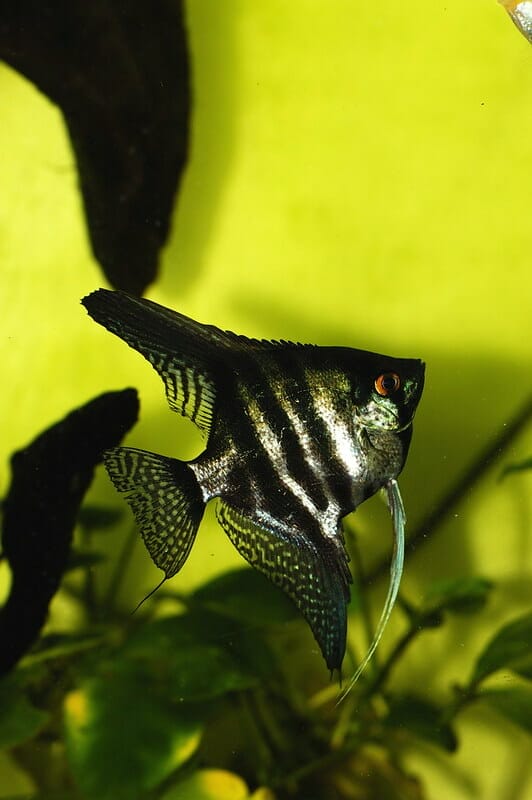
Image by li yong under CC BY-SA 2.0
Zebra angelfish looks similar to silver angelfish.
The difference between them is that silver angelfish have only three stripes on its body whereas zebra angelfish have 4-6 stripes on its body.
You will also notice some zebra angelfish have red-eye.
The red-eye is a sign of healthy and fully mature angelfish.
Zebra angelfish are relatively peaceful fish and you can keep it in a community tank.
But you should avoid keeping it with the fish that are smaller than the size of the mouth of angelfish because they may eat them.
You should also avoid keeping dedicate vertebrates and other small spaces with zebra angelfish.
But you can easily keep larger shrimp and snails with the zebra angelfish.
Like all the angelfish, zebra angelfish prefers warm water in the tank.
Zebra angelfish are omnivorous and you should feed a variety of food like frozen or live bloodworms, brine shrimp as well as some veggies and flake food.
8. Koi Angelfish
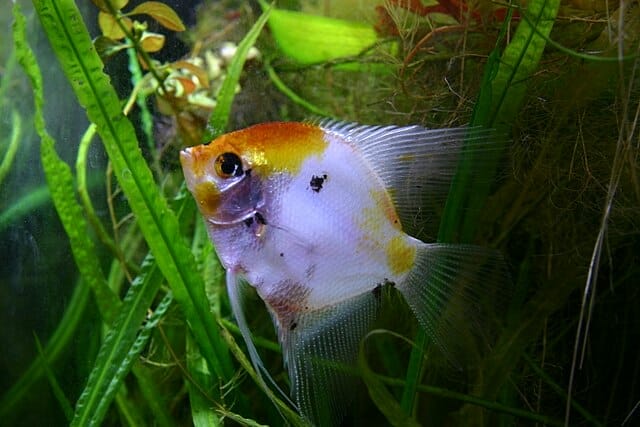
Image source under CC BY-SA 3.0
Koi angelfish look similar to Japanese koi fish.
This fish has black and white coloration and it has an orange color on its head.
The amount of orange coloration depends on the stress level of the fish.
If the fish is more stressed out then the coloration will be darker.
When Koi angelfish are young will also notice red hue below their eyes.
And it will fade away as they get older.
This fish looks similar to Golden marble angelfish but it does not have any stripes on the body.
You should keep this fish in at least a 30-gallon tall tank and you should also keep a lot of live plants in the tank.
You can also introduce some rocks and driftwood to emulate the natural habitat of the fish.
Besides, Koi angelfish are omnivorous and you should feed it a variety of food.
You can feed it live and frozen bloodworms, brine shrimp as well as veggies regularly.
While feeding vegetables just make sure to boil and cut them down into small pieces so that it will be a lot easier for angelfish to consume it.
12 Benefits of Live Plants in an Aquarium
9. Golden Marble Angelfish
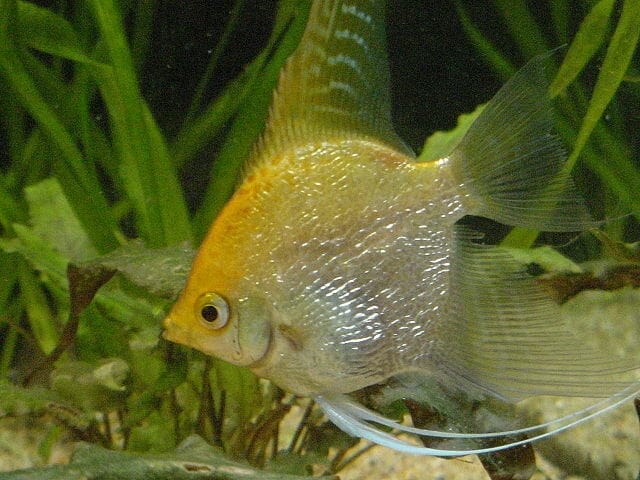
Image by Neil916 under CC BY-SA 2.5
Golden marble angelfish look similar to Koi angelfish.
It is actually considered as a subtype of Koi angelfish.
This fish features a wide range of coloration but black, white, yellow color with gold patches are very common in this fish.
It has light coloration on the head and body along with dark black markings.
Also, no two fish will look similar there will be at least some differences in them.
It is also fairly common fish in the aquarium trade so you may easily find it in most of the aquarium shops.
This fish is very easy to care for and maintain which makes it a very good choice for beginners.
Ideally, you should keep it in a heavily planted tank of at least 30 gallons.
And you should also introduce some rocks and driftwood to emulate the natural habitat of the fish.
As with all the angelfish, you should feed a variety of food like veggies and meaty food to this fish.
You can feed it frozen or live bloodworms, brine shrimp as well as vegetables like spinach and zucchini and flake food.
10. Half Black Angelfish
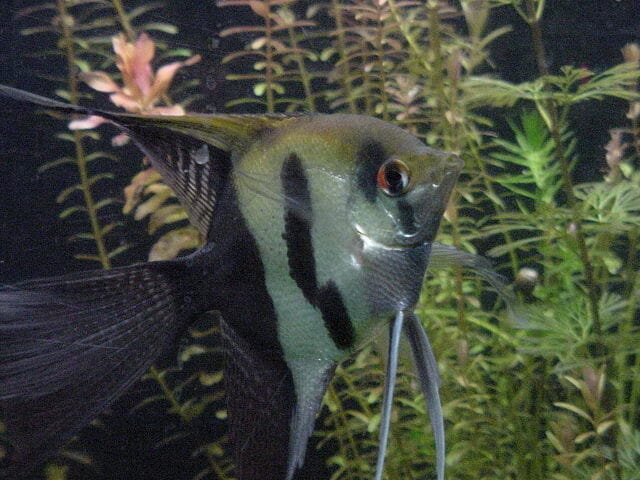
Image by Neil916 under CC BY-SA 2.5
Half black angelfish is one of the common angelfish in the aquarium hobby and you can find it relatively li easily in aquarium shops.
This fish is in the aquarium hobby for more than half-century.
The front of this angelfish is glimmering silver in color and the rear is black in color.
This fish requires a lot of space to swim around and it can get very big.
So ideally you should keep it in at least a 30-gallon tank or more.
This fish is found in Amazon basins with a lot of vegetation.
So you should try to emulate the same in your tank and keep it in a heavily planted aquarium.
Besides, you should feed it a variety of food.
Half black angelfish is omnivorous but its diet is primarily a protein-rich meaty diet.
So you should feed it meaty food such as frozen or live bloodworms, brine shrimp, etc as well as vegetables.
Vegetables should not be its primary diet and you can feed it vegetables a couple of times a week.
Before feeding the vegetables make sure to boil it and cut it down into small pieces so that it will be a lot easier for it to consume.
11. Altum Angelfish
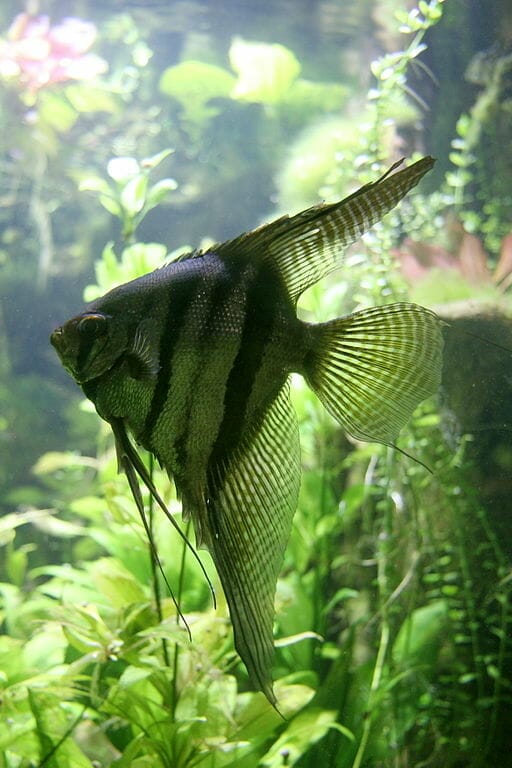
Image source under CC BY 2.0
Altum angelfish are the largest type of angelfish.
Generally, other types of angelfish grow maximum 6 inches long and 8 inches tall but Altum Angelfish grows nearly 7 inches long and 9 inches tall.
This fish features a silver body along with dark black or reddish-brown stripes on the body.
You may also see some red or greenish-blue spots on the body of some Altum angelfish.
Also, all true Altum angelfish have notch above the nares.
It is also one of the rare angelfish in the aquarium hobby.
This is because it is very difficult to breed in captivity and it is exclusively wild-caught.
However, recently some hobbyists have successfully bred it in captivity.
Also, there is a hybrid known as Orinoco altum which is developed by the cross-breeding of P.
Altum and P. Scalare.
The way to identify pure Altum angelfish from Orinoco fish is that the Orinoco Altum will not have notch above the nares.
Altum angelfish is the most peaceful type of angelfish and it can even get frightened by shadow and any fast movement near the tank, especially when you bring it for the first time in your new tank.
It takes some time to get comfortable and used to the tank environment.
It is also relatively difficult fish to keep in the aquarium because it does not tolerate fluctuations in the water parameters.
The ideal temperature range for this fish is between 80 to 90 degrees Fahrenheit.
The pH tolerance range is between 4.8 to 6.2 and the hardness should be below 5.
For successfully keeping this fish in the tank, you must maintain these parameters.
Ideally, you should keep it in a planted tank of at least 30 gallons or more.
And like all the other types of angelfish, you should provide it a variety of diet containing veggies and meaty foods such as frozen or live bloodworms, brine shrimp as well as flake food.
20 Tips to Maintain a Healthy Aquarium
12. Albino Angelfish
Albino angelfish are relatively common fish in the aquarium trade so you may easily find it in the aquarium shops.
This fish is not found in the wild and it is exclusively bred in captivity.
It is commonly bred in the United States and some parts of southern Asia.
This fish lacks dark pigmentation but it may retain yellow to red pigments which results in white to yellow body.
You can easily identify it by its pink eye.
This fish is highly susceptible to diseases and it also has a relatively short lifespan.
Its ancestors live in densely vegetated areas of Amazon so you should try to emulate the same in your tank and keep it in a heavily planted aquarium.
You should also add some rocks and driftwood.
As with all the Angelfish, you should feed it a variety of food.
You can feed it frozen and live bloodworms, brine shrimp.
Usually, angelfish are very fond of blood worms and it is said that it also stimulates their breeding behavior.
Besides, you can also feed it vegetables.
13. Smokey Angelfish
There are many different types of smoking angelfish in the aquarium hobby.
A few examples include Smokey leopard angelfish, Smoky blushing angelfish, Smokey marble angelfish, etc.
Smokey angelfish features dark pigmentation on the rear part of the body, generally on the fins.
The dark pigmentation varies from fish to fish.
Some fish will have very dark pigmentation and others will have dark patches on the fins.
Also, the patches are not identical.
It is also very easy to get confused between half black angelfish and smoke angelfish.
A simple way to differentiate both the angelfish is that Half-black Angelfish will have a very well defined pigmentation border whereas the smokey will have a blur and nonstraight border.
The smoky phenotype can be easily seen even in a one-month-old fry.
It is said that the lighting conditions under which the fry is kept affect the dark pigmentation.
To maintain healthy coloration you should feed a variety of food to the smoke angelfish.
Its diet primarily consists of meaty food such as bloodworms, brine shrimp, etc.
But you should also feed it vegetables and flake food regularly.
Ideally, you should keep Smokey angelfish in a heavily planted aquarium.
You should also add a few rocks and driftwood to emulate its natural habitat.
Besides, maintaining good water quality is the key to successfully keeping smoke Angelfish in the aquarium.
What type of fish are Angelfish?

There are two types of angelfish:
- The freshwater angelfish
- The saltwater angelfish
The freshwater angelfish belongs to the cichlids family.
though it belongs to the cichlids family, it is relatively peaceful fish and you can keep other peaceful fish with angelfish as far as they are not fin-nippers.
Generally, angelfish live for about 10 years if you take good care of it.
And it can grow as long as 6 inches and as tall as 8 inches.
As it grows more tall than long, ideally, you should keep it in a tall tank.
They are not schooling fish so you don’t necessarily have to keep a group of angelfish together.
But keeping at least two Angelfish in a tank is recommended to encourage social interaction.
Angelfish are relatively hardy fish and can tolerate a decent range of water parameters.
So you can easily keep it in your tank as far as you are maintaining good water quality.
Angelfish Care
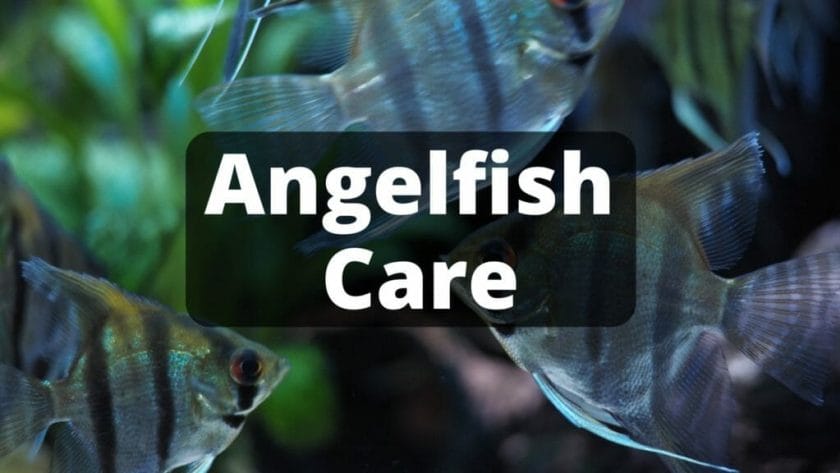
As mentioned earlier, angelfish are relatively hardy fish and can tolerate a decent range of water parameters.
But it is also very susceptible to diseases so maintaining good water quality is paramount for successful keeping Angelfish in an aquarium.
Below are the few points you should keep in mind to maintain healthy water quality.
Cycled tank
First of all, you should only put angelfish in a well-cycled tank i.e. the tank in which the nitrogen cycle is completed and nitrate and ammonia levels are zero.
Ideal water parameters
The ideal water parameters range for angelfish is as follows:
- PH- 6 to 7.5
- Temperature- 78-84 degree Fahrenheit
- Hardness- 5-13 DH
You should regularly check your water parameters and keep it within the ideal range.
Food
For healthy and thriving angelfish, you should feed it a variety of food.
Angelfish diet is primarily a protein-rich diet that mostly consists of meaty food like bloodworms, brine shrimp, etc.
But as Angelfish is omnivorous you should also feed it vegetables regularly.
You can feed it spinach, zucchini, etc.
Before feeding the vegetables make sure to boil it and cut it down into small pieces so that it will be a lot easier for it to consume.
Tank
Angelfish can get as long as 6 inches and as tall as 8 inches.
It gets more tall than long so ideally, you should keep angelfish in a tall tank.
You should also make sure that it is getting enough space to swim around.
A good rule of thumb to follow is 29 gallons for a pair of angelfish.
The natural habitat of angelfish consists of a lot of vegetation.
So you should emulate the same and put it in a well-planted aquarium.
You should also add some rocks and driftwood to emulate the natural habitat.
7 Best Aquarium Plants For Angelfish
Tankmates
Though angelfish belong to cichlids family it is relatively peaceful fish.
And you can easily keep it in a community tank.
There are a few things you should keep in mind while choosing tank mates for angelfish
- Angelfish have long fins so you should avoid keeping fin nipper fish with your angelfish
- Angelfish are also not very quick at swimming so you should avoid keeping fast-moving fish with your angelfish. This is because, while feeding, the chances are the angelfish will not get sufficient food. And at the same time, other fish will overeat. Both cause applications.
- You should also avoid keeping the fish that are smaller than the size of the mouth of your angelfish. Because angelfish may eat them if they are very small in size.
FAQ
Can different types of Angelfish breed?
Yes, different types of angelfish can breed.
In fact, domestic freshwater angelfish are a result of breeding various different types of angelfish i.e. angelfish that have different background body colors and stripes.
What are the smallest angelfish?
Leopard angelfish are the smallest angelfish.
This fish can get a little bit more than half of a fully grown common angelfish.
It can grow up to 4 inches long and 7 inches tall.
Can angelfish live without an air pump?
An air pump is not absolutely necessary for any aquarium if you have a good surface agitation.
If you don’t have good surface agitation then you should keep an air pump in your aquarium.
Besides, having an air pump in a tank is generally a good idea. Because in case your filter fails the air pump will keep the tank well oxygenated for about a week or so. Check out our recommended Air Pump
Besides, there are also a lot of factors that come into play while deciding you need an air pump or not.
For example, if you have a lot of plants in your aquarium then you don’t need an air pump. Because most likely the plants are going to provide sufficient oxygen to your angelfish.
In fact, keeping an air pump in a heavily planted tank can be harmful to the plants.
This is because plants absorb carbon dioxide just as we need oxygen.
So if you introduce an air pump in the water tank then they will not get sufficient carbon dioxide that can cause complications.
Conclusion
So these are the different types of angelfish you can keep in your freshwater aquarium.
I hope you found this article helpful.
If you do, please share it.
Also, let me know if you have any doubts in the comments section below.
Happy fishkeeping!